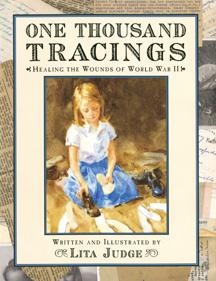Full Text Reviews: Bulletin for the Center... - 10/01/2007 Based upon a true family story, this account in brief, lyrical vignettes describes an American family’s post-World War II humanitarian work of sending shoes to needy families overseas by matching donated shoes to paper foot-tracings sent by families in need. Employing the viewpoint of Judge’s mother, then a child, the passages themselves are simple, but they reflect the impact that the relief effort had on the young girl; her tone is childlike but aware, and she is most personally affected by the project when the family receives letters from children like her (a subplot focuses on her pen-pal relationship with a little girl named Eliza). Illustrations include both full-page watercolor portraits and photographs of artifacts (foot tracings, letters, photos) and period realia (a bar of soap, a ball of yarn). The combination of artistic formats is initially a bit jarring, but each helps to tell the story in its own way. Though this is reminiscent of Fleming’s Boxes for Katje (BCCB 10/03), it’s interesting that this story focuses on succor for Germans, America’s erstwhile enemy, and it’s even more interesting that the book never mentions the former opposition (particularly poignant when one of the German kids runs around calling himself “Merikaner”) and treats the German experience as representative of Europe’s in general. Overall, this tale of a single relief effort speaks to the impact of even the smallest act of kindness in times of hardship; in all, more than three thousand pairs of shoes were sent to families in need of footwear. Share this with young listeners as a point of inspiration for performing small deeds for those in need. A detailed author’s note is included. HM - Copyright 2007 The Board of Trustees of the University of Illinois. School Library Journal - 07/01/2007 Gr 2-5-After she discovered a box containing hundreds of tracings of feet in her grandparents' attic, Judge wrote this story of their generosity following World War II in the voice of her mother, a child at the time. When the Hamerstroms received a letter from their German friend, Dr. Kramer, informing them of his family's dire need in the war's aftermath, they mailed food and clothing. His thank-you note contained the plea: "Please send no more to me. Help others." Kramer provided names along with so many foot tracings for shoes that the Hamerstroms began a letter campaign asking other American families for help. They knitted, collected clothing and shoes, and mailed an ever greater number of packages. The exchange resulted in a friendship between the narrator and a young German girl, Eliza. The gift of a rag doll for Eliza was repaid with a painting of a swallow. Each page of text describes activities between 1946 and 1948, and several are punctuated with quotes from actual letters. The soft-edged paintings are colorful and fluid and create a strong sense of time and place. Collages of letters, foot tracings, and original photographs heighten awareness of the suffering brought upon thousands in war-torn Europe. Judge's endnote describes her attic discovery. This unique and important book illustrates how reaching out to others, even those once considered the "enemy," can help to heal the wounds of war.-Marianne Saccardi, formerly at Norwalk Community College, CT Copyright 2007 Reed Business Information. - Copyright 2007 Publishers Weekly, Library Journal and/or School Library Journal used with permission. Booklist - 05/15/2007 Judge bases this quiet, moving story of kindness and healing on her own family’s history. After World War II, her grandparents organized a relief effort from their Midwest farm and sent care packages to more than 3,000 desperate people in Europe. In each spread, a young girl describes how she helps Mama with the packages. The stirring art in Judge’s first picture book includes not only beautiful, full-page watercolor paintings of a family making a difference but also dramatic collages of black-and-white photos, newspaper cuttings, letters that Judge found in her grandparents’ attic, and the foot tracings sent by Europeans desperate for shoes. There is no talk of the enemy. Judge focuses on the dramatic, realistic details of those in need (“We have only one pair of boots and must take turns”) and the strength of those who fought “a battle to keep families alive” after the military battles were over. - Copyright 2007 Booklist. Loading...
|



